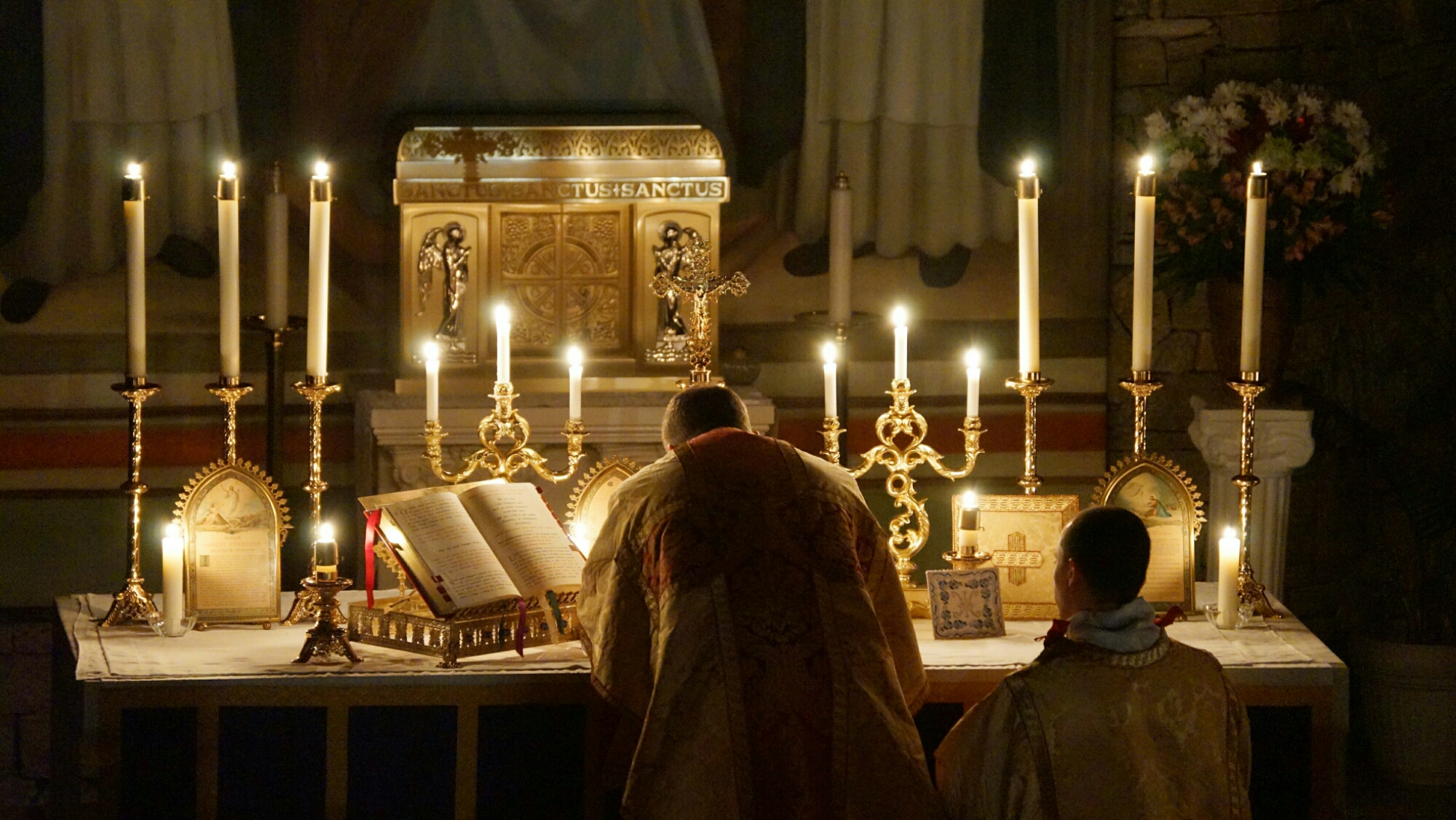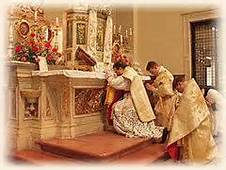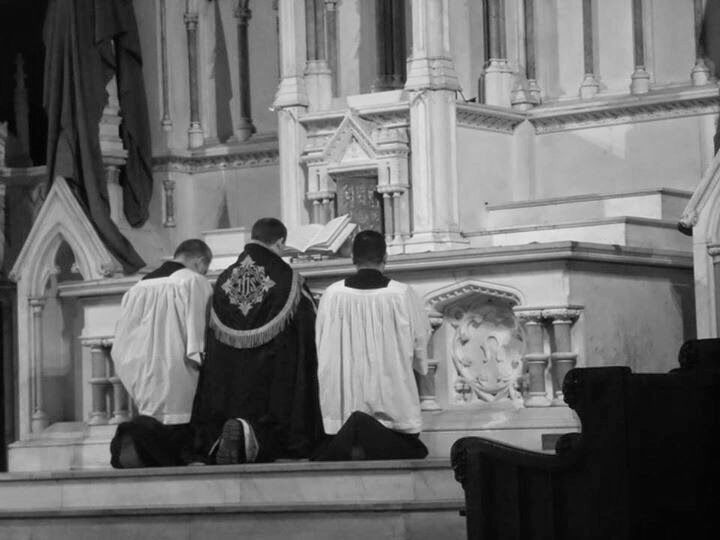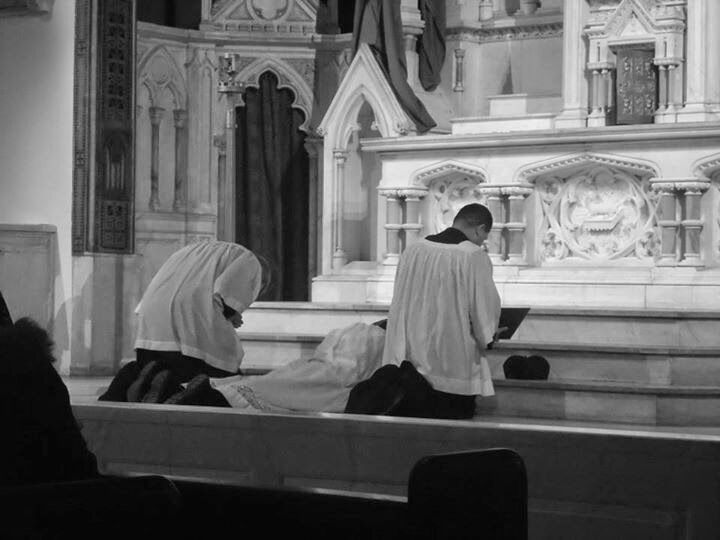
For a long time the celebrant merely bowed after each elevation of our dear Lord in Holy Communion.
It wasn’t until 1570 that the genuflection became part of the rite according to The Mass A Study of the Roman Liturgy. The genuflection in the Mass signifies adoration, or very special reverence or supplication. Therefore, it is used (1) to express adoration of the Sacred Species (e.g., before or after touching the Sacred Host), or of Our Lord in relating acts of adoration that were or are given Him (e.g., the adoration of the Magi in the Mass of the Epiphany); (2) to express special reverence for the mystery of the Incarnation (e.g., the genuflection in the Creed or in the Prologue of St. John’s Gospel) or for the Holy Ghost (e.g., the genuflection at the words Veni, Sancte, Spiritus at Pentecost); (3) to express humility and penance (e.g., at Flectamus genua of penitential Masses) or special fervor of supplication (e.g., at Adjuva nos in the Tract of some Lenten Ferial Masses).
The Simple Genuflection in Low Mass
 A simple genuflection is made by the Celebrant uncovered unless he is carrying the chalice and then it’s covered (1) On his way to or from the altar if he passes before the Blessed Sacrament enclosed in the tabernacle, or a relic of the Sacred Passion is exposed for veneration in the chief place over the altar or if he passes an altar where Mass, after the Consecration and before the Communion, is in progress. (2) While moving on arrival at and before departing from an altar at which the Blessed Sacrament is reserved in the tabernacle, or a relic of the Sacred Passion is exposed for veneration in the chief place above the altar. (3) On the step before beginning Mass at an altar where the Blessed Sacrament is reserved. (4) Towards the Missal always at Flectamus genua, when it occurs in certain penitential Masses. (5) Towards the Missal; unless the Blessed Sacrament is exposed, then towards It. Towards the Missal whenever, by a special rubric, a genuflection is ordered in the Epistle, Tract, or Gospel (e.g., the Epistle of Palm Sunday, the Gospel of the Epiphany). (6) In the Creed ( at Et incarnates est, etc.). (7) Before and after each Elevation of the Sacred Species. (8) Before and after each touching of the Sacred Host, or after each uncovering and after each covering of the chalice, between the Consecration and the Communion. (9) If Holy Communion be given, having opened and before closing the tabernacle and the ciborium.
A simple genuflection is made by the Celebrant uncovered unless he is carrying the chalice and then it’s covered (1) On his way to or from the altar if he passes before the Blessed Sacrament enclosed in the tabernacle, or a relic of the Sacred Passion is exposed for veneration in the chief place over the altar or if he passes an altar where Mass, after the Consecration and before the Communion, is in progress. (2) While moving on arrival at and before departing from an altar at which the Blessed Sacrament is reserved in the tabernacle, or a relic of the Sacred Passion is exposed for veneration in the chief place above the altar. (3) On the step before beginning Mass at an altar where the Blessed Sacrament is reserved. (4) Towards the Missal always at Flectamus genua, when it occurs in certain penitential Masses. (5) Towards the Missal; unless the Blessed Sacrament is exposed, then towards It. Towards the Missal whenever, by a special rubric, a genuflection is ordered in the Epistle, Tract, or Gospel (e.g., the Epistle of Palm Sunday, the Gospel of the Epiphany). (6) In the Creed ( at Et incarnates est, etc.). (7) Before and after each Elevation of the Sacred Species. (8) Before and after each touching of the Sacred Host, or after each uncovering and after each covering of the chalice, between the Consecration and the Communion. (9) If Holy Communion be given, having opened and before closing the tabernacle and the ciborium.
The Double Genuflection in Low Mass
The Celebrant makes a double genuflection (1) On his way to or from the altar if he passes before or near the Blessed Sacrament exposed, or meets a priest carrying It, the Elevation of Mass, or actual Benediction with the Blessed Sacrament, is taking place, and he remains kneeling until the chalice or monstrance has been replaced on the altar, or Holy Communion is being distributed, having adored, the Celebrant proceeds on his way. (2) While moving on arriving at, and before, departing from an altar where the Blessed Sacrament is exposed for adoration. (3) Towards the Missal in the reading of the Passion in Holy Week, at the words exspiravit or emisit spiritum.
kneeling until the chalice or monstrance has been replaced on the altar, or Holy Communion is being distributed, having adored, the Celebrant proceeds on his way. (2) While moving on arriving at, and before, departing from an altar where the Blessed Sacrament is exposed for adoration. (3) Towards the Missal in the reading of the Passion in Holy Week, at the words exspiravit or emisit spiritum.
General Rules of Genuflections
1) The double genuflection is made only on first arriving at the altar, and before departing at the end of Mass; all other genuflections in the course of Mass are simple genuflections. 2) During Mass, each time on his arrival at the middle of the altar from the side, and each time before his departure from the middle to the side, the Priest is to make a simple genuflection to the Blessed Sacrament. This genuflection is made immediately on his arrival, so that it is his first action at the middle, or immediately before his departure, so that it is his last action there. 3) Each time that the Priest turns from the altar to address the people he first genuflects, and he repeats the genuflection on again facing the altar. If the Priest is at the middle when about to turn (for example at the end of the Gloria in excelsis), he first kisses the altar and then genuflects; but if he arrives at the middle immediately before turning to the people, as he does after the Communio, he first genuflects, then kisses the altar and turns.
When there is more than one Scripture reading, preceded by a prayer and followed by a Gradual, which occurs on the Wednesdays and Saturdays of Ember weeks, on the  Wednesday of the fourth week of Lent and on that of Holy Week, having said the Kyrie, eleison at the center as usual, the Priest does not say Gloria in excelsis (if it occurs), nor Dominus vobiscum, but returns with joined hands to the Missal. There he says Oremus as usual (opening and closing his hands and bowing to the cross), then laying both hands flat on the altar, one at each side of the Missal-stand, he genuflects (always towards the book, even if the Blessed Sacrament be exposed), while saying Flectamus genua. He rises at once from the genuflection, while the server replies Levate, and says the prayer as usual. Then for the reading and the Gradual which follow he lays his hands on the book or altar as for the Epistle. Thus he says each to the center of the altar, says the Gloria (if it is to be recited), kisses the altar, says Dominus vobiscum, returns tot he book, and recites the Collect and other prayers (if they occur) as usual. In the Ember Week of Pentecost, Flectamus genua is not said because of the joyous character of Paschaltide.
Wednesday of the fourth week of Lent and on that of Holy Week, having said the Kyrie, eleison at the center as usual, the Priest does not say Gloria in excelsis (if it occurs), nor Dominus vobiscum, but returns with joined hands to the Missal. There he says Oremus as usual (opening and closing his hands and bowing to the cross), then laying both hands flat on the altar, one at each side of the Missal-stand, he genuflects (always towards the book, even if the Blessed Sacrament be exposed), while saying Flectamus genua. He rises at once from the genuflection, while the server replies Levate, and says the prayer as usual. Then for the reading and the Gradual which follow he lays his hands on the book or altar as for the Epistle. Thus he says each to the center of the altar, says the Gloria (if it is to be recited), kisses the altar, says Dominus vobiscum, returns tot he book, and recites the Collect and other prayers (if they occur) as usual. In the Ember Week of Pentecost, Flectamus genua is not said because of the joyous character of Paschaltide.
